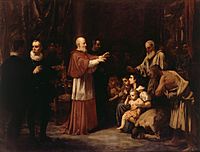Juan de Ribera facts for kids
Quick facts for kids SaintJuan de Ribera |
|
|---|---|

Saint Juan de Ribera.
|
|
| Archbishop | |
| Born | 20 March 1532 Seville, Spain |
| Died | 6 January 1611 (aged 78) Valencia, Spain |
| Venerated in | Roman Catholic Church |
| Beatified | 18 September 1796, Saint Peter's Basilica, Rome, Papal States by Pope Pius VI |
| Canonized | 12 June 1960, Saint Peter's Basilica, Vatican City by Pope John XXIII |
| Major shrine | Royal College of Corpus Christi, Valencia, Spain |
| Feast | 6 January |
| Attributes | Episcopal attire |
Juan de Ribera (born in Seville, Spain, on March 20, 1532 – died in Valencia, on January 6, 1611) was a very important person in Spain during the 1500s and early 1600s. He was an Archbishop (a high-ranking church leader) and also the Viceroy of Valencia (a ruler representing the king). He was also the Commander in Chief and led the University of Valencia. The Catholic Church recognized him as a saint in 1960.
Contents
Juan de Ribera's Early Life and Education
Juan de Ribera's father was Pedro Afán de Ribera. He was the Viceroy of Naples and a Duke. Juan's mother passed away when he was very young.
Juan de Ribera went to the University of Salamanca to study. In 1557, he became a priest. When he was 30 years old, in 1562, Pope Pius IV made him the Bishop of Badajoz.
Becoming a Leader in Valencia
As Bishop of Badajoz, Juan de Ribera focused on teaching the catechism (religious lessons) to Catholics. He also worked to stop the spread of Protestantism in the area.
In 1568, he became the Archbishop of Valencia. This was a very important church position. Later, in 1602, King Philip III of Spain also made him the Viceroy of Valencia. This meant he was in charge of both religious and government matters in Valencia.
Juan de Ribera founded a special school called the Museum of the Patriarch. People in Valencia often called it the College of Saint John. This college was created to train priests. It followed the rules and ideas set by the Council of Trent, which was an important meeting for the Catholic Church.
The Expulsion of the Moriscos

As Archbishop, Juan de Ribera had to deal with a big issue in Valencia. This was about the Morisco people. The Moriscos were descendants of Muslims who had been forced to become Christians. They were told they would be exiled if they did not convert.
The Moriscos were kept separate from other people. They could not hold public jobs or become priests. Because of this, they kept their own culture. Some of them secretly continued to practice their original religion.
Juan de Ribera did not like the Moriscos. He believed they were not true Christians. Many other Christians in Valencia felt the same way. Juan de Ribera, along with the Duke of Lerma, helped convince King Philip III to remove the Moriscos from Spain.
In 1609, the king ordered the expulsion of the Moriscos from Spain. Juan de Ribera also suggested that the king could take all the Moriscos' property. This money would then go to the royal treasury.
Becoming a Saint
After Juan de Ribera died, people wanted him to be recognized as a saint. He himself had worked to make Ignatius of Loyola a saint.
There were some questions about his sainthood. One concern was his role in the expulsion of the Moriscos. However, his supporters argued that he followed other important rules of the Council of Trent. They also said that his attempts to convert the Moriscos had not worked.
Many books were written praising Juan de Ribera. In 1796, he was beatified. This is the step before becoming a saint. Finally, in 1960, Pope John XXIII officially made him a saint.
See also
 In Spanish: Juan de Ribera para niños
In Spanish: Juan de Ribera para niños

